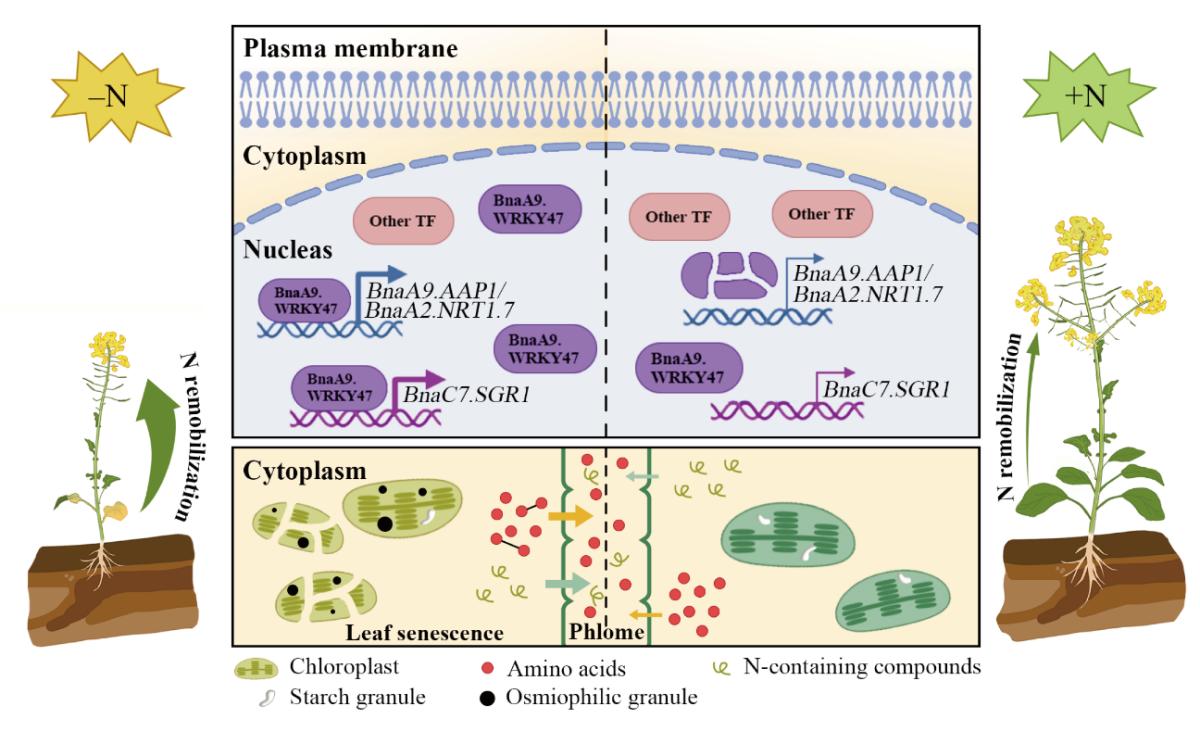南湖新闻网讯(通讯员 崔蕊)近日,我校资源与环境学院植物营养生物学团队研究成果“The transcription factor BnaA9.WRKY47 coordinates leaf senescence and nitrogen remobilization in Brassica napus”在植物学杂志Journal of Experimental Botany上发表。
甘蓝型油菜根系吸收的总氮中,大约48%从营养组织回收到成熟的种子中,另外大约15%的氮因落叶而损失。因此,改善衰老叶片中的氮素回收,提高氮素再利用效率十分重要。研究发现,BnaA9.WRKY47超表达植株表现出叶片提前衰老,叶绿体降解的表型。BnaA9.WRKY47超表达株系的籽粒产量较野生型显著提高;相反,BnaA9.WRKY47功能缺失突变体的产量降低。
通过生化实验分析,研究团队发现BnaA9.WRKY47直接激活持绿基因BnaC7.SGR1以加速老叶黄化衰老。研究表明伴随着缺氮诱导的叶片衰老,超表达株系老叶中氨基酸浓度升高,氮素再分配能力提高。同时BnaA9.WRKY47能够协同激活氨基酸渗透酶BnaA9.AAP1和硝酸盐转运蛋白BnaA2.NTR1.7。因此,研究团队提出缺氮胁迫下油菜提高氮素再利用理论模型:缺氮上调老叶BnaA9.WRKY47基因的表达,增加老叶中BnaA9.WRKY47蛋白丰度,BnaA9.WRKY47上调了BnaC7.SGR1、BnaA2.NRT1.7和BnaA9.AAP1的表达,从而促进了甘蓝型油菜老叶的衰老以及氮素向新生组织或种子的再转运,有利于缺氮胁迫下油菜达到养分资源配置最大化。

图1 BnaA9.WRKY47调控甘蓝型油菜响应氮饥饿的工作模型
我校植物营养生物学团队博士研究生崔蕊为论文第一作者,徐芳森教授和汪社亮副教授为共同通讯作者,我校石磊教授、已毕业博士冯英娜和硕士研究生姚金亮也参与了该项研究。该研究得到了国家重点研发计划和国家自然科学基金的支持。
审核人:汪社亮
论文链接:https://academic.oup.com/jxb/advance-article/doi/10.1093/jxb/erad282/7227263
英文摘要:
Nitrogen (N) is an essential macronutrient for plants, and N remobilization is key for plant adaptation to N deficiency stress. However, there is a limited understanding of the regulatory mechanisms of N remobilization in Brassica napus. Here, we report a transcription factor, BnaA9.WRKY47, induced by N starvation. At the seedling stage, BnaA9.WRKY47-OE lines displayed earlier senescence of older leaves and preferential growth of juvenile leaves compared to the wild-type ‘Westar 10’ under N starvation. At the field scale, the seed yield was significantly increased in BnaA9.WRKY47-OE lines compared to ‘Westar 10’ grown under N deficiency conditions and, conversely, reduced in BnaA9.WRKY47-mutants. Biochemical analyses demonstrate that BnaA9.WRKY47 directly activates BnaC7.SGR1 to accelerate older leaf senescence. In line with leaf senescence, the amino acid concentration was elevated, and the N distribution was reduced in the older leaves of OE lines. This result is because BnaA9.WRKY47 activates the amino acid permease BnaA9.AAP1 and the nitrate transporter BnaA2.NRT1.7. Therefore, the expression of BnaA9.WRKY47 efficiently facilitates N remobilization from older to younger leaves or seeds. Taken together, the results of this study demonstrate that BnaA9.WRKY47 upregulates the expression of BnaC7.SGR1, BnaA2.NRT1.7 and BnaA9AAP1 thus promoting the remobilization of N in B. napus under N starvation.